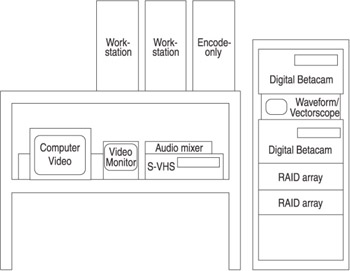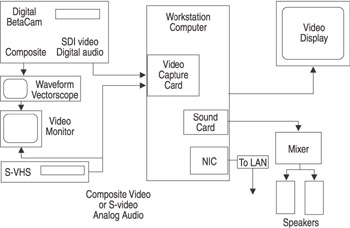Putting it Together
The equipment is laid out on a heavy duty computer lab bench and standard 19-inch equipment rack in the encoding room, as shown in figure 10.3. The computers are located on shelves above the bench; monitors and miscellaneous source devices are located on the bench; and the Digital Betacams, waveform monitor/vectorscope, and RAID arrays are mounted in the rack. With this approach, one operator can manage both work-stations and one or more encode-only computers. A simple keyboard/video/mouse (KVM) switchbox is installed so the operator can control the three computers easily.

Figure 10.3: Layout of encoding equipment in the lab.
Of course there are many ways to enhance and customize the layout. For example, encode-only computers, arrays, source machines, and workstations can be added to increase productivity.
Figure 10.4 shows how a workstation is wired. In this layout, sources are hard-wired to workstations. As the facility expands, audio and video routing will be added so sources can be easily patched into different workstations. A workstation is built as follows:

Figure 10.4: Wiring layout for the encoding equipment.
-
Computer configuration. The video capture card, NIC, and audio monitoring sound card are installed according to the manufacturers’ instructions.
-
Equipment mounted in racks. The Digital Betacams, waveform monitor/vectorscope, and RAID arrays are installed in the equipment rack. They place the waveform monitor/vectorscope between the Digital Betacams and at eye level to make it easier to see when configuring the VCRs.
-
Digital Betacam monitors. The Digital Betacams provide a number of output options. In the Contoso lab, they connect the composite video output to one input of the waveform monitor/vectorscope, and then connect the output of the waveform monitor/vectorscope to one input of the video monitor. Then they connect the other Digital Betacam to the second input of the waveform monitor/vectorscope. If the waveform monitor/vectorscope supports switching outputs, when the staff switches between the VCRs on the waveform monitor/vectorscope, the video will switch in the video monitor. If the monitor/scope does not support switching, you could connect the second input of the video monitor to the second Digital Betacam. For more information about the different audio and video formats Contoso will be working with, see the connector sidebar in chapter 2.
-
Digital Betacam main output. The SDI outputs of the Digital Betacam decks connect to the SDI inputs of the video capture cards (if supported). For audio, you can connect the AES/EBU digital audio outputs of the Digital Betacams to the video capture cards (again, if supported). In some cases, you can use the digital audio embedded in the SDI connection instead of making a separate audio connection. When playing back an analog tape, the Betacams convert the signals and output digital data through the SDI and AES/EBU ports.
-
S-VHS deck. The output of the S-VHS deck or other source is connected to the appropriate input of the video capture card. Many video capture cards support several input options. If your source device provides an S-video output, use that. Otherwise connect the video output to the composite input on the card. Also, connect the analog audio output of the device to the card. You can use a DV or IEEE 1394 (sometimes called FireWire) connection to record from a MiniDV camcorder or deck. If the source has a second composite video output, connect that to the video monitor.
When setting up a capture session, you will use the capture dialog box to select which inputs to take audio and video from. For example, to capture from the Digital Betacam, you will choose SDI video and digital audio inputs.
-
KVM switch. The keyboard, video display, and mouse are connected through the KVM switch to the three computers.
-
Audio monitoring. The sound card line outputs of the three computers are connected to three input channels on the small audio mixer. Then the mixer output is connected to a pair of speakers. The operator can select which computer audio output to monitor by selecting the appropriate channel on the mixer.
-
Network. Finally the computers are connected to the LAN. Files can be copied over the network to other local computers or sent to the hosting service using FTP. An encode-only computer can also connect to source files located on an array over the network. Keep in mind, however, that the network does not provide enough bandwidth for real-time streaming of full-sized, uncompressed video.
With the workstations and production systems installed and running, the Contoso staff can now capture and encode content.
EAN: 2147483647
Pages: 258